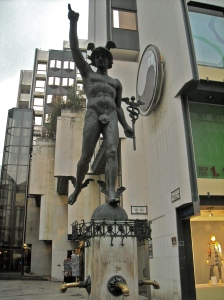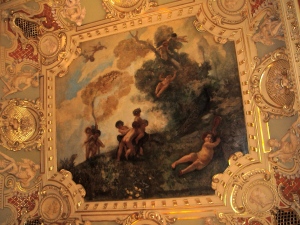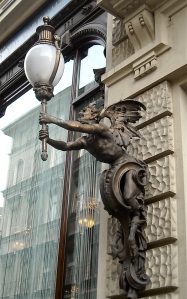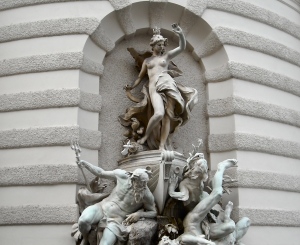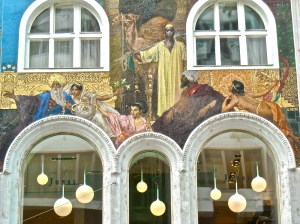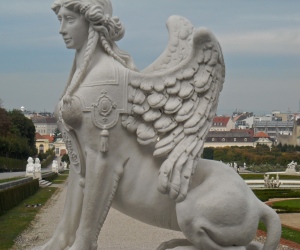Last month, bringing along my dragonfly-adorned luggage, I had the good fortune to take a trip along the Danube River, a river as storied as the Nile, mother of the history of many peoples and many empires. The area I covered on this journey once belonged to the territory of the Hapsburg Emperors, whose love of opulent buildings has left to posterity the pearls of a string of cities. There was statuary everywhere, much of it dedicated to beings and themes from classical Greek or Roman mythology. From Budapest to Vienna to Prague, the urbanscapes fairly bristled with gods and goddesses along with angels and demons, saints and sinners. They looked upon the modern traffic, both pedestrian and vehicular, from some very picturesque street corners, rooftops and building facades.
Strolling along one of the wide pedestrian-only avenues lined with both modern and 19th Century baroque buildings in the heart of the Pest side of Budapest one comes upon a handsome statue of Hermes/Mercury himself looking down upon the people strolling by, as they are coming in and out of shops, no doubt approving of the commerce being conducted all around him. Besides being the god of communication, the messenger god, he has endured the centuries as the patron of merchants (and also of thieves).
In another part of that graceful city, guarding the opera house, is a sphinx, that enigmatic creature that is half woman and half lion. No doubt she is guarding the secrets of that creature who walks on four, then two, then three legs, whose stories are sung in soaring song within that elegant venue. (Look up the riddle of the sphinx.)
The New York Café, which is nothing like any café I have ever seen in New York, is brimming with fat cherubs skimming the ceilings. We call them “cupids”, even though there is, in myth, only one Cupid, son of Venus. In fact these little fellows are seen often in both secular and sacred settings throughout the places I visited. Full of good cheer and exuberant enjoyment, they flit through the architecture and artwork that is everywhere. As Paul Simon sang, “There are angels in the architecture…”
More mysteriously and a bit alarmingly, the lamps outside the café are held aloft by devilish figures. Perhaps they are a warning to be circumspect in consumption of the gastronomic delights and addictive beverages served there.
In Vienna, the parade and display of mythical power and grace continues. The chariot of a mighty war goddess, Minerva or Athena, bears down upon the one who dares look up to the roof of the Hofburg.
Not far away Jupiter and Juno, or Zeus and Hera, hold court, models for the Emperor and his Empress.
Venus/Aphrodite is busy banishing the turbulent god of the waters, Neptune/Poseidon, calming the oceans, no doubt to facilitate the shipping that underlies the prosperity of the realm.
Scenes from an exotic tale (Is it the Arabian Nights?) adorn the wall of a shop in vivid colors.
At the Belvedere Palace where one of the art museums is housed, one comes across Ops (source of the word “opulent”) or Abundancia (root of “abundance”) with a cornucopia that flows with flowers and fruit. She is accompanied by a cherubic child.
And around the corner, looking over the sweep of vast gardens, is another sphinx, this one winged.
In Prague, much of the iconography on public buildings has a more Christian or historical cast of characters, but the familiar and archetypal signs of the zodiac figure prominently on the famous astronomical clock in the central plaza of that gorgeous town.
Prague has so many unique and beautiful buildings with mythic and symbolic adornment that I could include many photos that I took. I might have to write another blog about these. But here is one that features a medieval figure on horseback.
Steeped in myth, history, legend and sacred imagery, Europe’s heartland seems both bound and liberated by the many stories and memories all those images evoke. In Prague there is a place where other, more contemporary, rougher and less defined images, which have their own personal mythology, are painted randomly and anonymously. They appear on a wall in the square where the Velvet Revolution began, where young people gathered and defiantly played music banned by the last empire.
“Imagine” that.


